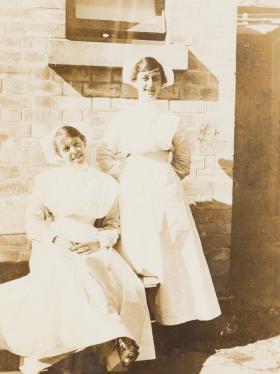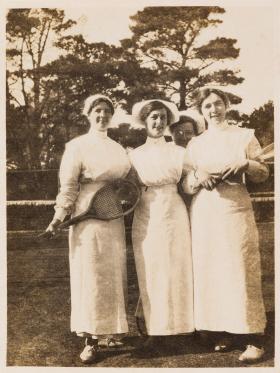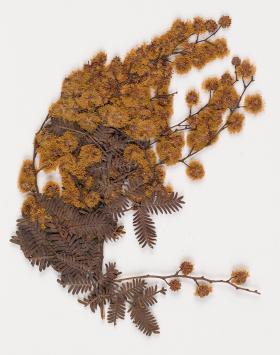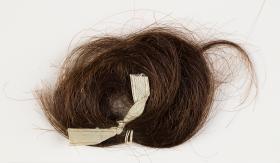It is more than 30 years since John Oliver Dark deposited in the Mitchell Library a set of letters that his mother wrote to his father before, during and after the First World War.
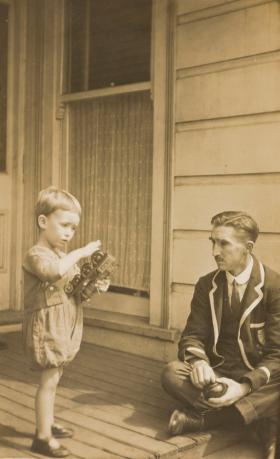
Eric Dark went on to enjoy a long marriage to celebrated Australian novelist Eleanor Dark, and his marriage to Daidee is occasionally mentioned as a brief prologue to that larger cultural story.
But the ‘Daidee letters’, as they are called, have their own story to tell. Although they can now only be read in light of the tragedy that was to come, their vitality and ardour paint a detailed self-portrait of a young middle-class Australian woman coming to emotional and sexual maturity in the second decade of the twentieth century.
Daidee, born in 1892, and Eric, born in 1890, met when they both lived with their families on Sydney’s lower north shore. She began training as a nurse at Royal Prince Alfred Hospital in 1914 and he, already studying medicine and in love with her from 1912, arranged to be posted there so that he could see her more often.
Eric proposed marriage early on, but for several years Daidee didn’t reciprocate the depth of his feelings. In her first letter, written some time before war broke out in 1914, she wrote:
… thank you for the handkerchiefs. They were very pretty and it was good of you to send them; but I don’t know if you realise that you are making me have to be very careful what I say when you are here. This is the second time you have given me something I mentioned I would like, and if you don’t mind I would rather you didn’t go spending your money on things for me …
yours sincerely
D Raymond
But Daidee offered Eric friendship, which he accepted with a view to his longer-term hopes. The couple picnicked together, took day trips to Narrabeen on Sydney’s northern beaches, toured Centennial Park and went on boating excursions. At the hospital, Eric was able to meet up with Daidee casually, escort her out on her days off and help her with her studies.
In 1915, in return for an early graduation, he volunteered to join the British Army as a doctor. Daidee and Eric’s correspondence, of which only her letters survive, began in earnest.
Daidee’s early wartime letters were full of gossipy news about the hospital, friends and family members. She bemoaned the dreariness of cookery classes, made fun of her teachers, grumbled about punitive nursing sisters, and complained about her workload, especially during prolonged stints of night duty. She asked for Eric’s thoughts about the nurses and doctors they knew, and derided ‘catty’ colleagues who ‘think they are upper class … when really a lot of kitchen maids wouldn’t lower themselves by talking as they do’.
While Eric was running field ambulance units in the trenches of France and Belgium, Daidee kept up an active social life in Sydney: in the hospital common room, on the tennis court, on wildflower excursions, on day trips to Sans Souci, and at morning and afternoon teas at Farmers’ department store. She attended public talks about the war and queued for hours to buy half-price tickets to hear Dame Nellie Melba. She visited Sydney landmarks: the Royal Botanic Garden, the Art Gallery of NSW, and the newly opened Taronga Park Zoo. She enjoyed holidays with friends to Avoca, Palm Beach and the Blue Mountains. In between, she studied, read, played music, and sewed almost all her own clothes, as well as gifts for friends and family. And she knitted socks for soldiers.
On the fashionable topic of spiritualism she reported heated arguments within her family, and she was also sceptical of the miraculous cures promised by Christian Science. In 1917 she complained about the General Strike, which she called the ‘tram and train strike’. Later that year, she attended a public meeting at Sydney Town Hall about the second conscription referendum, addressed by Prime Minister Billy Hughes. She hoped sincerely that the ‘yes’ vote would come out ‘on top’ because she was worried that too few men were doing their patriotic duty, as Eric was.
But as she developed, both as a nurse and a young woman, her natural exuberance was softened by life’s experiences. After the death from septicaemia of a young patient, Thelma, she asked, ‘Why have little things like that got to suffer so, it seems so wicked.’ She recounted the profound grief experienced by the parents of a three-year-old boy whose malignant eye tumour meant certain death. And she prayed for the hasty demise of a male patient because he would be released from unbearable pain.
As hostilities deepened half a world away, they began to puncture Daidee’s life at home. When her brother Eric and her cousin Jack enlisted, she wrote to Eric Dark that it was ‘a horrible sort of feeling to have, that they may be going to their death’. Her brother returned but Jack did not, dying not of wounds but of influenza and pneumonia. Towards the end of 1918, when peace seemed probable, Daidee wrote that the welcome news only made her sad, because ‘when flags are flying and boats whistling and everyone [is] going mad it makes one pretty blue’.
But alongside Daidee’s experiences on the home front is the compelling story of her increasingly warm long-distance relationship with Eric, with a barely submerged subtext of her sexual awakening.
As Daidee’s feelings deepened, the gifts the couple exchanged became more personal. She sent Eric a copy of the new literary sensation The Songs of a Sentimental Bloke, a silk scarf she knitted for him, sprigs of wattle from his family home and hers, boronia from Narrabeen, and forget-me-nots for remembrance. A tiny parcel containing a little bronze boomerang engraved with the words ‘I go to return’ was lost en route to Europe.
Eric sent her sheet music, photographs of himself in uniform, and pictures of the famous English medieval country house Haddon Hall. Extravagant gifts of a dressing case and furs, probably a matching collar and muff, were received with enthusiasm: the furs were ‘deliciously warm’ and it was absolutely ‘bonz’ of him to send them.
In early 1917, having accepted Eric’s proposal in a letter that does not survive, Daidee wrote that it was ‘funny to be engaged to a man who has never even kissed me. You can have a double lot when you come back. No-one else ever had any, you can have all I had in store.’
But her feelings were not unequivocal. While at times she said the sight of him was the only thing that could make her happy, she also expressed her doubts about her capacity to be fully ‘in love’ with anyone. She described herself as behaving like a ‘pig’ to him before he went to war, but also said, ‘I miss you terribly sometimes only I simply can’t make up my mind one way or another whether I want you or whether I don’t.’
Eric came back to Australia on leave after he was gassed at Passchendaele, and he and Daidee married in late January 1918. Ten weeks later, he returned to the war. From that time, her letters were filled with rapturous references to the physical side of marriage but she also recalled that her blissful response was not immediate. She reminded him of the Saturday night before the ceremony: ‘You absolutely scared me in the work room the way you kissed me. You seemed to be demanding body and soul from my lips and I just felt as if I couldn’t let you have what you wanted. I’ve heard of kisses scorching. That one did.’
Later, she told Eric she was ashamed of saying ‘don’t’ so often in the first weeks of marriage ‘but I did feel a very sick girl … going away with you was such a complete step out of one life into another’. She reminded him that it had taken time for her feelings to change. ‘Think hard for a few minutes, just remember the very first time you made me respond to you absolutely and you will find it was about three or four weeks after Jan 25th [their wedding day].’
She was increasingly frank about her own desires: ‘it was absolutely awful the barefaced way I made love to you. Personally I think I did just as much love-making as you did’. On his return, he could kiss her anywhere he liked, ‘and you did have quite a lot of favourite little spots didn’t you?’
Before Eric left Australia, Daidee wrote him a letter that he would receive when he returned to the war: ‘Do you remember the night, only two ago now … when I’ve lay with your head on my breast, or my head tucked into your neck and shoulder and just talked quietly for hours. The hours we had later on won’t bear putting into words, they were too exquisite to be desecrated so.’
Eric had become her ‘dearest’ and her ‘best beloved’. When he returned from the war, the couple had a year in which to cherish one another. Eric later gave Daidee’s letters to their son John, who gave them to the Mitchell Library in 1988 with other material belonging to his father. These letters ensure that the mother he never knew has not been forgotten.
Historian and writer Margo Beasley was a 2018 Visiting Scholar at the Library, researching the life of Eric Payton Dark.

